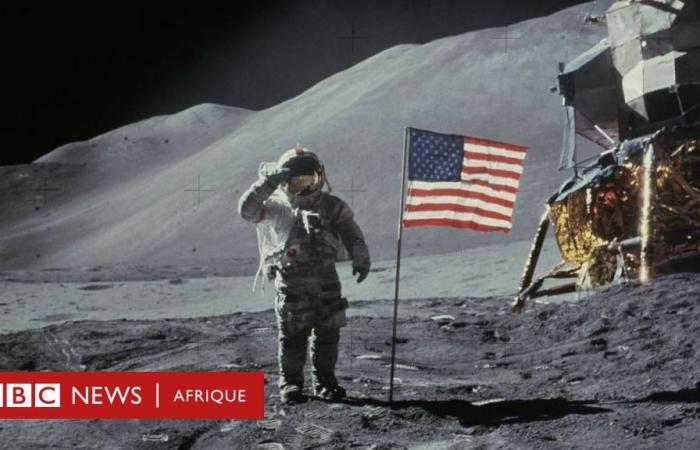
Photo credit, Getty Images
- Author, Rebecca Morelle
- Role, BBC science editor
-
June 19, 2024, 08:00 GMT
We are in full moon fever. A growing number of countries and private companies have the Earth’s satellite in their sights in a race for resources and domination of space. But are we ready for this new era of its exploration?
Images of the Chinese flag displayed on the Moon have made headlines this month. This is the Asian country’s fourth moon landing and the first mission to bring samples of its hidden side back to Earth.
Over the past 12 months, India and Japan have also landed spacecraft on the lunar surface. In February, American company Intuitive Machines became the first private company to land a lander on the Moon. And many other missions are underway.
For its part, NASA wants to send humans to the Moon again. Astronauts on the Artemis mission plan to land on the Moon in 2026. China says it will send humans in 2030. And instead of fleeting visits, its plan is to build permanent bases.
But at a time of renewed push by the great powers, this new space race – after that started in the 1960s – could cause tensions on Earth to reach the lunar surface.
“Our relationship with the Moon will change radically very soon,” warns Justin Holcomb, geologist at the University of Kansas (United States).
The speed of space exploration “is beyond our laws,” he says.
Does the Moon have an owner?
A 1967 UN agreement states that no country can claim ownership of the Moon. Instead, the Outer Space Treaty affirms that space belongs to us all and that all exploration must be carried out in the interests of all humanity and in the interests of all nations.
Although it sounds very peaceful and collaborative – which it indeed is – the driving force behind the Outer Space Treaty was not cooperation, but Cold War politics.
Photo credit, Getty Images
As tensions between the United States and the Soviet Union increased after World War II, there were fears that space would become a military battlefield. The key element of the treaty, then, was that nuclear weapons could not be sent into space. More than 100 countries have signed it.
A new and important factor is that modern lunar missions are not only projects of nations, but also private companies.
In January, a U.S. trade mission called Peregrine announced it would deliver human ashes, DNA samples and a branded sports drink to the Moon. A fuel leak prevented its arrival, but sparked debate over how to fit the expedition of this eclectic inventory into the principle that exploration should benefit all of humanity.
“We’re starting to send things there just because we can. There’s no logic or reason anymore,” says Michelle Hanlon, a space attorney and founder of For All Moonkind, an organization that attempts to protect the Apollo landing sites. “Our Moon is within our reach and now we are starting to abuse it,” he warns.
Precious lunar resources
But even though private travel is on the rise, country governments ultimately remain the key players in all of this. Sa’id Mosteshar, director of the Institute of Space Policy and Law in London, says any company needs state permission to go into space, which will be limited by international treaties.
Entering the select club of travelers to the Moon continues to enjoy great prestige. After the success of their missions, India and Japan can boast of being global space players.
And a nation with a thriving space industry can greatly boost the economy through jobs and innovation.
But the race to the Moon offers an even greater reward: its natural resources.
Photo credit, Getty Images
Although it appears quite barren, the lunar terrain contains minerals, such as rare earths, iron, titanium and helium, which are used in many fields, from superconductors to medical equipment.
Estimates of the value of all of this vary wildly, from billions to trillions of dollars. So it’s easy to understand why some view the Moon as a place where you can make a lot of money. However, it is also important to keep in mind that this is a very long-term investment and the technology needed to extract and return these lunar resources is still far from ready.
In 1979, an international treaty declared that no state or organization could claim ownership of lunar resources. But it was not very popular: only 17 countries signed it and none of them had been to the Moon.
In fact, in 2015, the United States approved a law allowing its citizens and industries to mine, use and sell any space hardware.
“This has caused immense consternation in the international community,” says Michelle Hanlon. “But gradually others followed suit with similar national laws,” including Luxembourg, the United Arab Emirates, Japan and India.
The resource with the highest potential
The most demanded resource on the Moon might be a surprising resource: water.
“When the first lunar rocks brought back by the Apollo astronauts were analyzed, they were thought to be completely dry,” explains Sara Russell, professor of planetary sciences at the Natural History Museum in London (UK).
“But there was a bit of a revolution about ten years ago and we discovered that they contained tiny traces of water trapped in phosphate crystals.
And at the Moon’s poles, he says, there’s even more: reservoirs of water ice are frozen inside craters.
Future visitors could use the water for drinking, to produce oxygen, and even to make rocket fuel by splitting it into hydrogen and oxygen, allowing them to travel from the Moon to Mars and beyond.
Photo credit, Getty Images
The Artemis Accords
The United States is currently trying to establish a new set of guiding principles for the exploration – and exploitation – of the Moon.
The Artemis Accords stipulate that the extraction and use of resources on the moon must be done in accordance with the Outer Space Treaty, while specifying that new rules may be necessary.
More than 40 countries have so far signed these non-binding agreements, but China is one of the notable absentees. For some, the new rules for lunar exploration should not be led by a single country, in this case the United States.
“This should be done through the United Nations, because it concerns all countries,” says Sa’id Mosteshar.
Photo credit, Getty Images
But access to resources could also cause another conflict.
Although there is plenty of space on the Moon, areas near ice-filled craters are prime targets. What will happen if everyone wants the same place to set up a base? And once one country has established one, what will stop another from establishing one too close?
“I think there is an interesting analogy with Antarctica,” says Jill Stuart, researcher in space policy and law at the London School of Economics (UK).
“We will probably see research bases set up on the Moon in the same way as on this continent.
This article was written and edited by our journalists with the help of an artificial intelligence translation tool as part of a pilot program.





